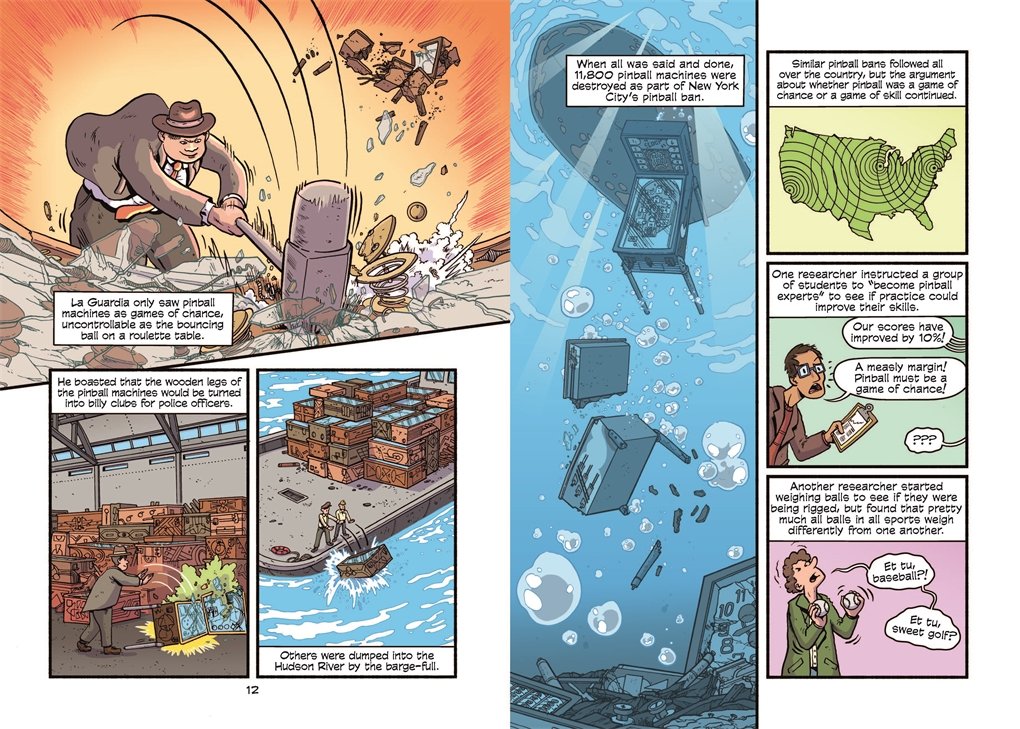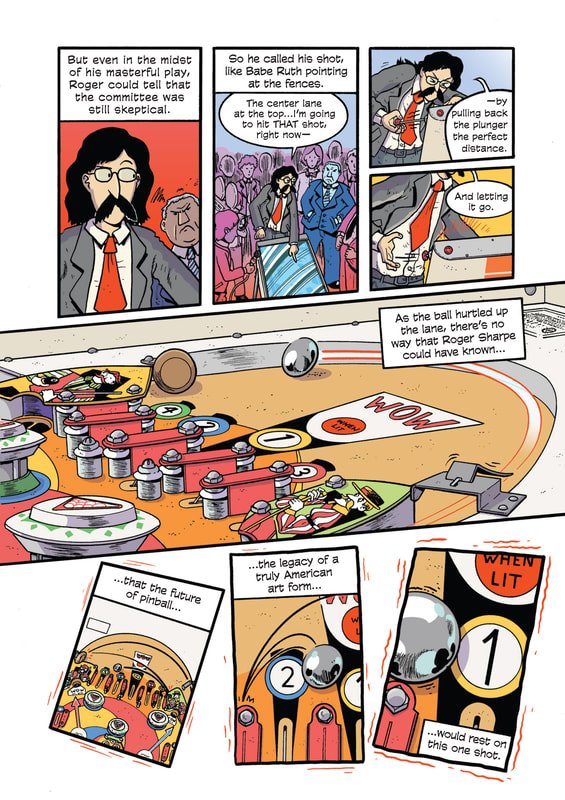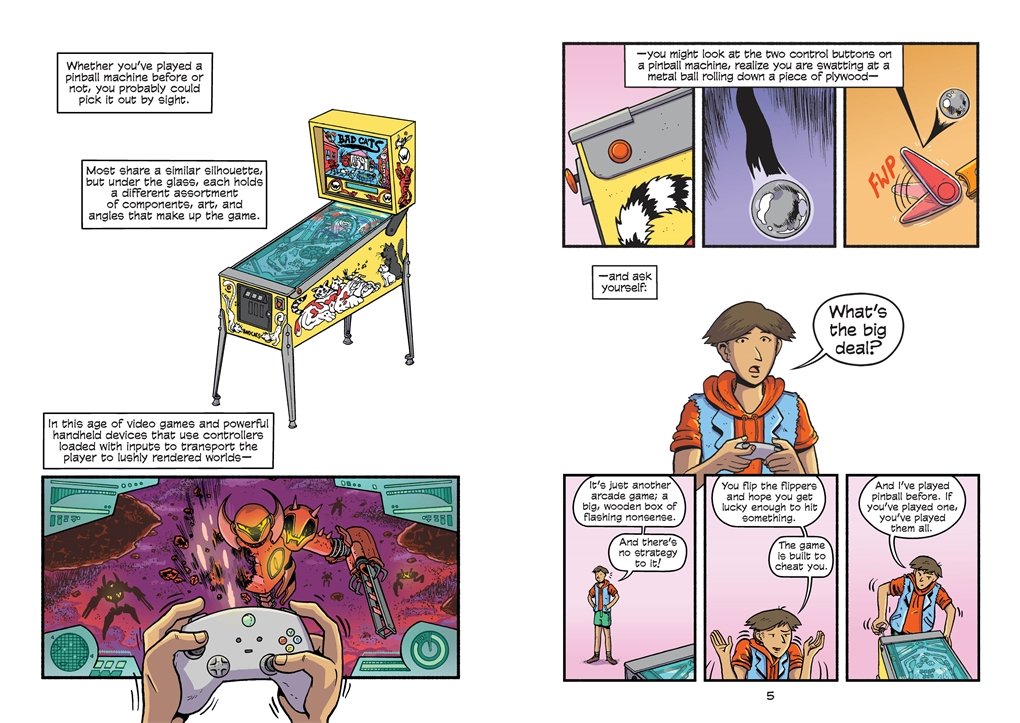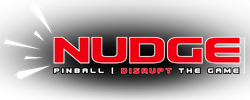I won’t teach you anything by telling you that at Pinball Mag. we obviously like to write about the wonderful world of pinball and, logically, to read everything about it.
And if, for a few years now, the press has followed the digitalization trend and is now almost exclusively concentrated on the Internet (this is the solution we have chosen for PinballMag), there are still a lot of paper books about pinball that exist and continue to be published more or less regularly.
In short, everything has already been more or less done on the subject and it is now complicated to bring its stone to the edifice in the middle of all these books that compose this “Pinball Library”.
Complicated? But not impossible. That’s what Jon Chad must have thought when he decided to publish a book that retraces the history of pinball, but in the form of… a comic book!


A mix as unlikely as it is tasty and which, in many ways, is not a simple rehash of the existing but a real visual journey in the history of pinball. It brings its share of novelties.
This little nugget, which has been out for a few weeks now, is making a lot of noise in the community and as we at the editorial office were able to put our little fingers on the book in question, we thought it would be a good idea to get out our best pen to say a few words about it!
In case you missed it…
Sommaire
Please… draw me a sheep!
At first glance, one might be tempted to say “but why make a comic book about the history of pinball?” I mean, what’s the point of releasing yet another version of the story we all know in a purely visual format in which the writing will be reduced to nothing but drawings everywhere?
Well, maybe it’s in the basics of school learning that we should go back. And yes, to imprint a message in our little pinhead brains (or not), a good drawing is better than a long speech. This is the characteristic of the first history books with which we study: Imaging for better understanding and better retention.

Indirectly, this is the approach chosen by Jon Chad in this book. Through drawings, explanatory diagrams, visual metaphors and graphic references, he popularizes several decades of pinball history. From the ancient Greeks (yes, we can see the beginnings of our hobby!) to the present day.
So much so that the average person who has never laid his hands on a pinball machine would be able to explain the historical outlines or detail the main characteristics of a machine after only two hours of reading!
The whole thing is sprinkled with a totally assumed subjective analysis of the contributions of pinball, its primary vocation, its ability to bring people together, its impact on our culture and sometimes even philosophizing on the relationship between man and machine.
Unexpected, but oh so fascinating!
Pinball is serious business!
We let ourselves slide with delight in this work which sends us back, for some of us, to our youthful comics. The eye catches on and we start to smile while reading the few bubbles punctuated by humorous visuals, funny jokes and situational comedy, sometimes cliché, but always well brought.
Don’t get me wrong, it’s not because the form of the book is definitely turned towards humor that the content has been put aside. Pinball – A Graphic History of the Silver Ball is accurate in its statements, accurate in its dates and complete in its explanations.
We will find all the key moments that make up the history of pinball, with in broad outline:
- La Guardia (Mayor of New York at the time) who, in the 1940s, threw dozens of pinball machines into the Hudson River
- Roger Sharpe, who literally saved our hobby by changing the mentality of those who considered it a vulgar game of chance and money
- The golden age of electro-mechanics and its first game movements to keep the ball
- The arrival of Solid State and its legendary themes
- The rescue attempt of Pinball 2000 with the Lawlor/Gomez duo
- Stern keeping its head above water during the 2000’s thanks to Gary
- And much more…

Except that the drawings and the omnipresent humor make the reading so fluid and fast that one would come to regret that the history of pinball is not more complete than that. We are faced with a perfect mix between the lightness brought by the humor and the historical facts.
In short, even if the book does not impose itself as THE most documented and exhaustive historical reference of pinball (this is not the goal at the same time), it has the merit of being sufficiently complete and detailed to allow everyone to have the basics of what will compose for several decades (and still today), our passion around the little silver ball.
How beautiful it is ?
When you start a work that mixes both visual narration and bubbles of comics, the whole on a niche hobby that mixes mechanics, electronics and artworks, the result must be nice to look at. Otherwise, you totally miss the point!
And here again, Jon Chad succeeds in his bet by delivering a realistic work without falling into the artistic over-performance. The visuals are beautiful and detailed enough for everyone to recognize without any difficulty the elements that make up a pinball machine, the designs of our legendary machines or the faces of the emblematic members who compose (or have composed) this universe.

The style used is not too marked either. Don’t expect a design or a colorimetry worthy of a US comic or faces straight out of Japanese mangas. No. Here the author keeps his own style which is close to the more “generic” visuals that can be found in newspaper illustrations for example. And it is finally what corresponds best to the theme.
It’s pretty enough to make you want to dwell on the details, and simple enough to make you want to go on with the story rather than spending 10 minutes contemplating a board as if it were a museum painting.
A book to bring them all together!
So it’s good, it’s nice but finally, what does it bring more than the existing one?
Well, simply the popularization! That of a niche hobby that contains its codes, its subtleties, its technicality and its complexity, whereas almost everyone finds themselves with a minimum of attraction for these machines as soon as their eyes cross a translite or an illuminated backglass.
And this is Jon Chad’s great strength. He succeeds in bringing together pinball aficionados, who will spend a pleasant moment around a visually polished book, filled with humor and fan service, and also “newbies” who will find a very good opportunity to get into the subject without having to spend several evenings dissecting the latest pinball bible and all the complicated terms that go with it.

The technical or gameplay aspects are systematically illustrated, like explanatory diagrams. The narration is adapted to a general public and the different threads, such as Roger Sharpe who crosses the different eras as if he was walking inside the book, offer enough dynamism to allow us not to give up after the 4th page.
Don’t forget the final glossary that allows everyone to brush up on their skills! What is a “Habitrail” or a “Stool Pigeon”? What is it?
What? Is it already over?
In its form, this book is a real Proust’s madeleine that one takes pleasure in tasting. The problem is that in two bites, it is already finished!
Yes, it’s beautiful to look at and we enjoy reading it but it’s still too short. It is the characteristic of the good things, we would like that they never finish!
The contract is certainly fulfilled and it would be unreasonable to ask for more. But you have to admit that a comic book about the world of pinball, which reminds us that we are still big kids and treats the subject with relevance and humor, it’s not so often that we get it, right?
So if you are sensitive to this graphic style and you were missing a new book in the middle of your pinheads books, go for it! You won’t be disappointed.
We warmly thank Jon Chad who allowed us to use visuals of his book to illustrate this article and we invite you to find him on social networks or on his website.

